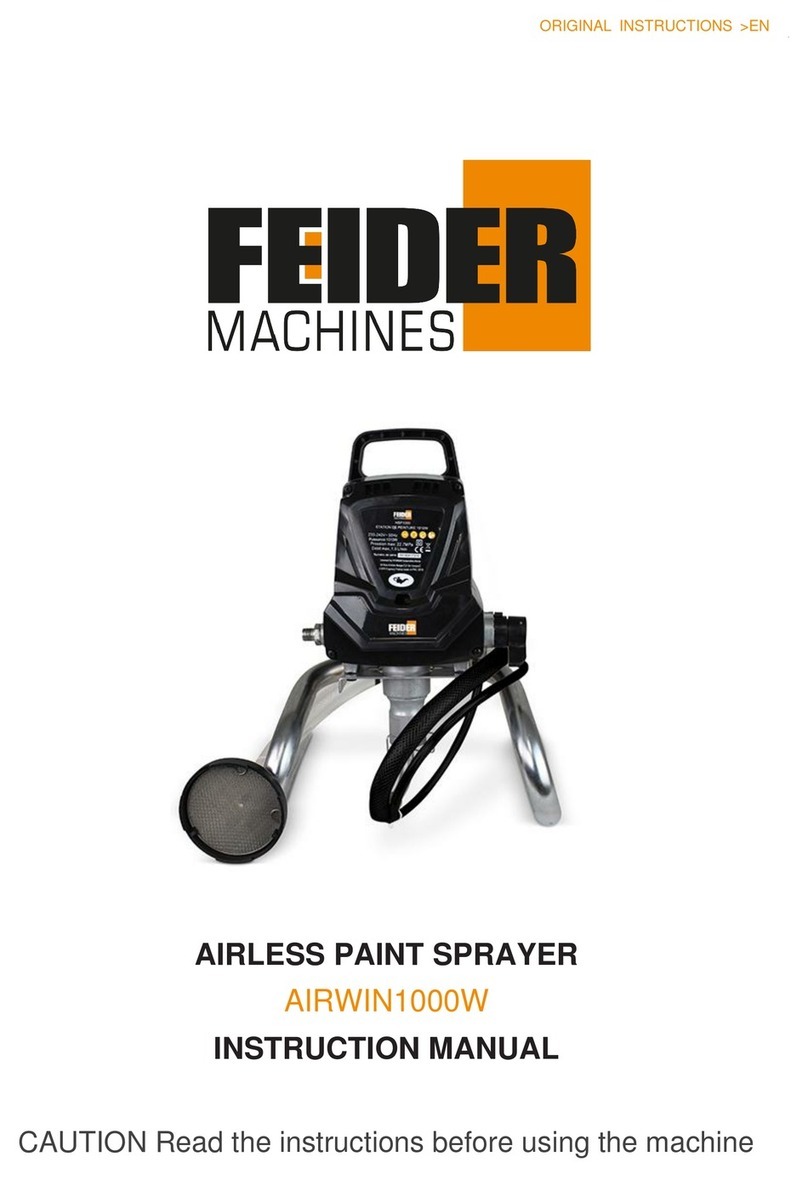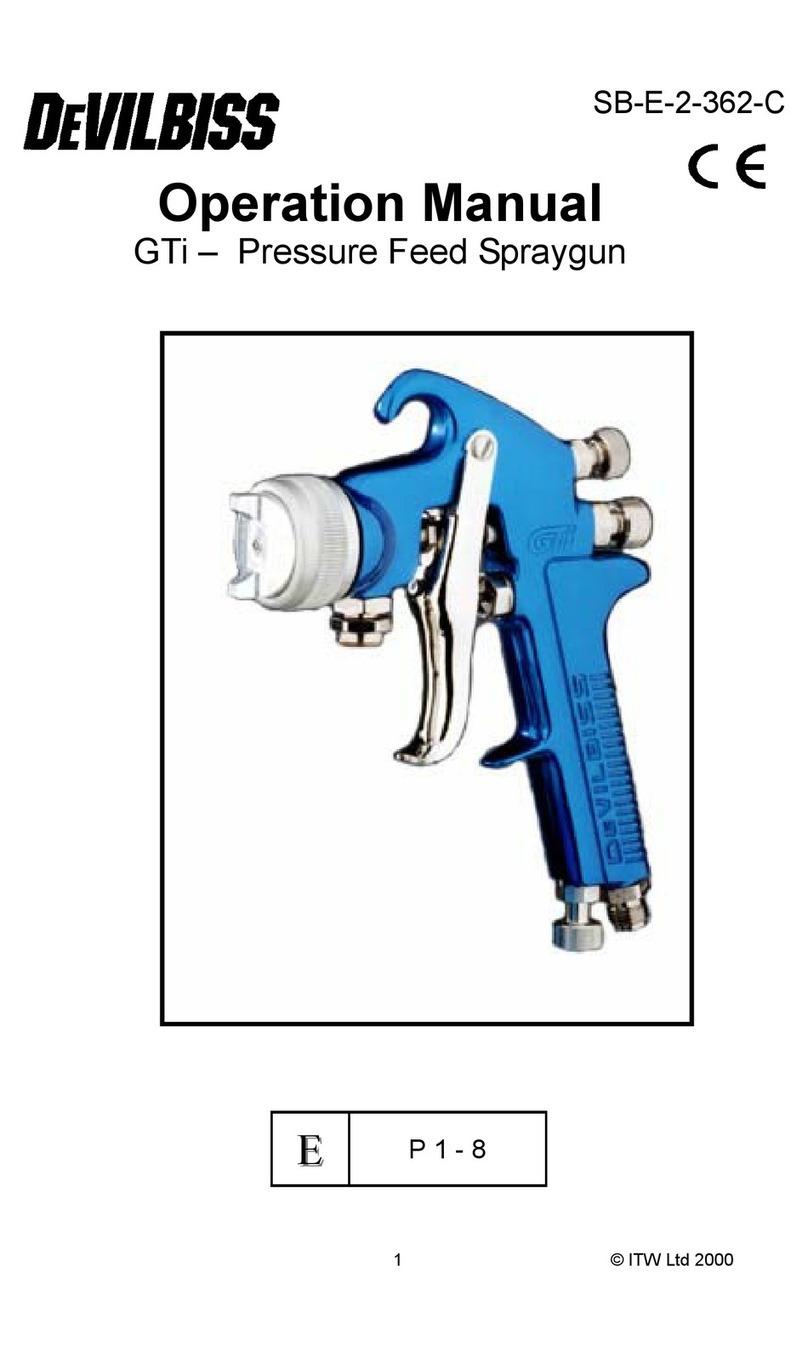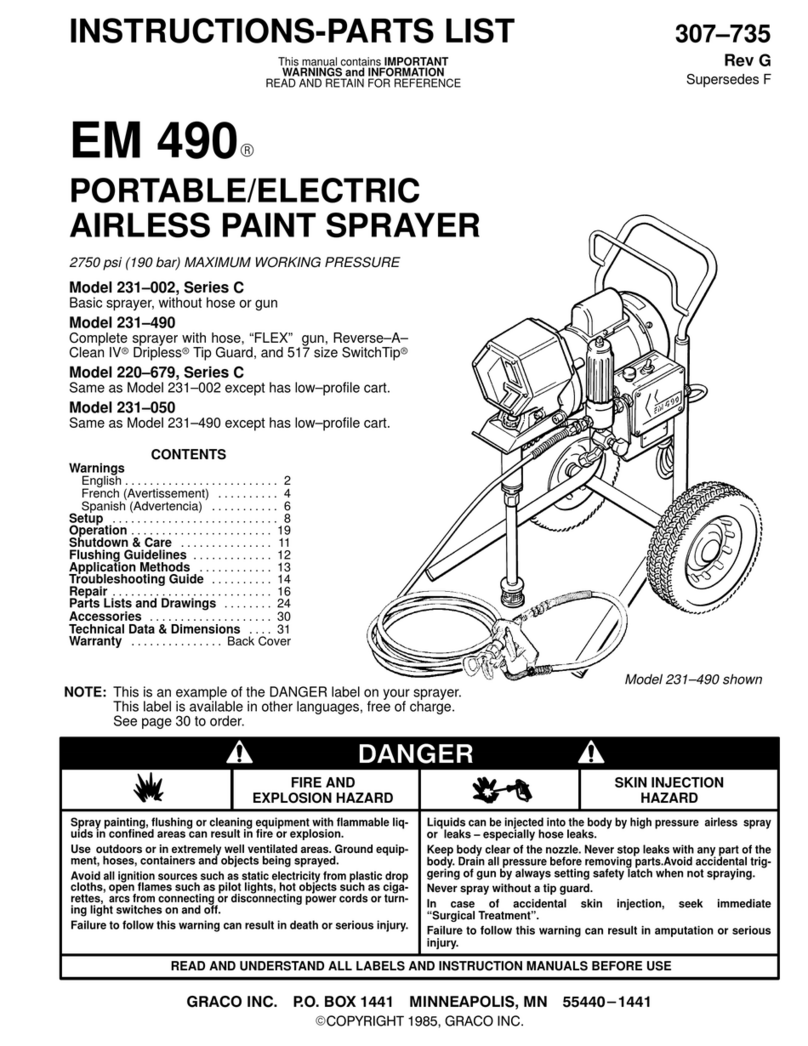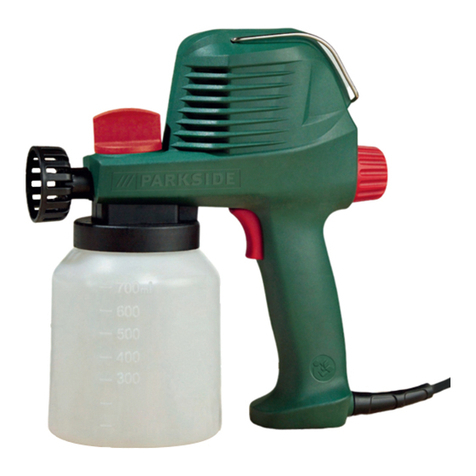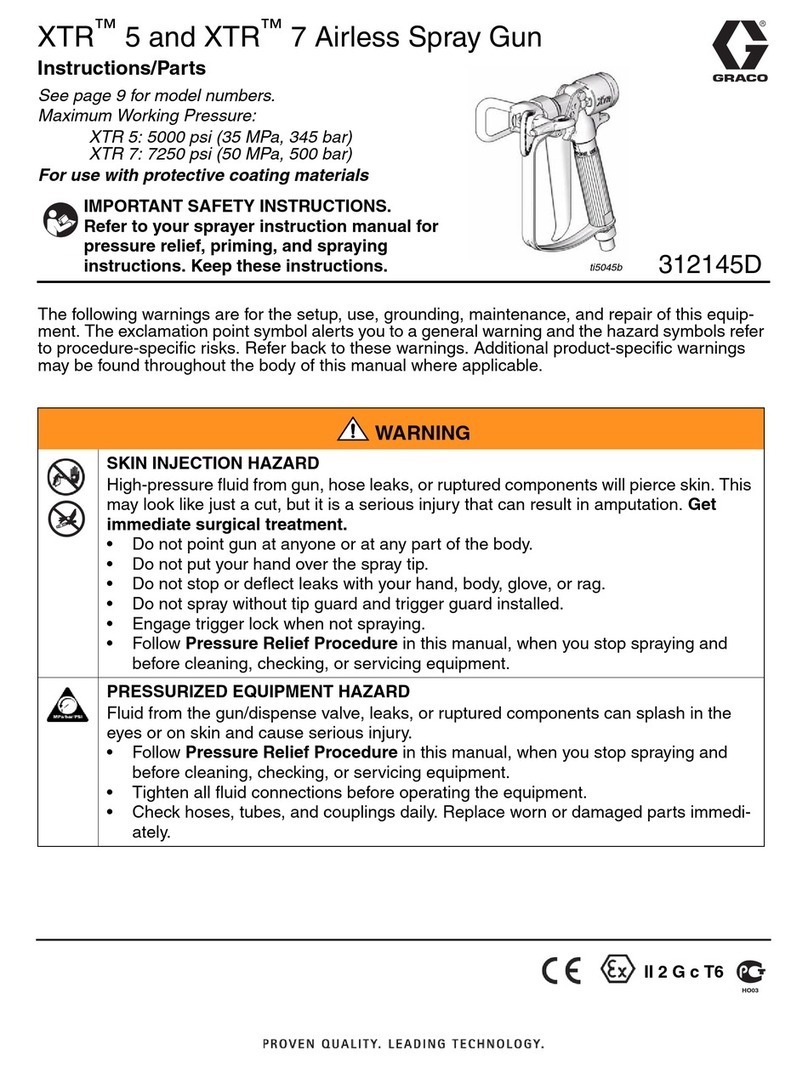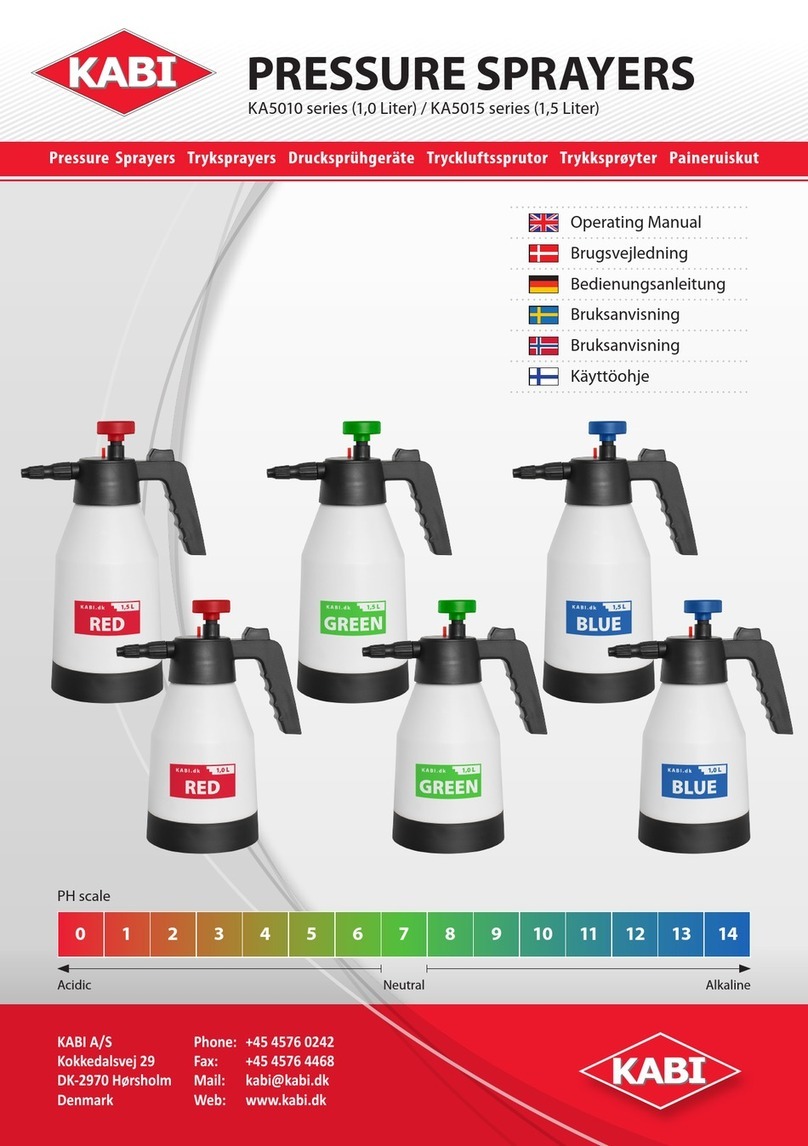Feider Machines FSP600W User manual

1
ORIGINAL INSTRUCTIONS
PAINT SPRAYER
FSP600W
USER GUIDE
CAUTION Read the instructions before using the machine
BUILDER SAS
32, rue Aristide Bergès - ZI 31270 Cugnaux – France
Made in PRC - 2020

2
CONTENT
1. GENERAL POWER TOOL SAFETY WARNINGS...........................................3
2. PAINT SPPRAYER SAFETY WARNINGS......................................................5
3. INTENDED USE..............................................................................................6
4. SYMBOLS.......................................................................................................6
5. PREPARING BEFORE USING.......................................................................7
6. USING THE DEVICE.....................................................................................11
7. MAINTENANCE AND CLEANING.................................................................12
8. TROUBLESHOOTING...................................................................................13
9. DISPOSAL ....................................................................................................13
10. DECLARATION OF CONFORMITY……………………………………...……..14
11. WARRANTY...................................................................................................15
12. PRODUCT FAILURE ....................................................................................16
13. WARRANTY EXCLUSIONS ..........................................................................17

3
1. General power tool safety warnings
WARNING: Read all safety warnings, instructions, illustrations and specifications provided
with this power tool. Failure to follow all instructions listed below may result in electric shock, fire and/or
serious injury.
Save all warnings and instructions for future reference.
The term "power tool" in the warnings refers to your mains-operated (corded) power tool or battery-
operated (cordless) power tool.
1) Work area safety
a) Keep work area clean and well lit.Cluttered or dark areas invite accidents.
b) Do not operate power tools in explosive atmospheres, such as in the presence of flammable
liquids, gases or dust. Power tools create sparks which may ignite the dust or fumes.
c) Keep children and bystanders away while operating a power tool. Distractions can cause you to
lose control.
2) Electrical safety
a) Power tool plugs must match the outlet. Never modify the plug in any way. Do not use any
adapter plugs with earthed (grounded) power tools. Unmodified plugs and matching outlets will reduce
risk of electric shock.
b) Avoid body contact with earthed or grounded surfaces, such as pipes, radiators, ranges and
refrigerators. There is an increased risk of electric shock if your body is earthed or grounded.
c) Do not expose power tools to rain or wet conditions. Water entering a power tool will increase the
risk of electric shock.
d) Do not abuse the cord. Never use the cord for carrying, pulling or unplugging the power tool.
Keep cord away from heat, oil, sharp edges or moving parts. Damaged or entangled cords increase
the risk of electric shock.
e) When operating a power tool outdoors, use an extension cord suitable for outdoor use. Use of a
cord suitable for outdoor use reduces the risk of electric shock.
f) If operating a power tool in a damp location is unavoidable, use a residual current device (RCD)
protected supply. Use of an RCD reduces the risk of electric shock.
3) Personal safety
a) Stay alert, watch what you are doing and use common sense when operating a power tool. Do
not use a power tool while you are tired or under the influence of drugs, alcohol or medication. A
moment of inattention while operating power tools may result in serious personal injury.
b) Use personal protective equipment. Always wear eye protection. Protective equipment such as a
dust mask, non-skid safety shoes, hard hat or hearing protection used for appropriate conditions will reduce
personal injuries.

4
c) Prevent unintentional starting. Ensure the switch is in the off-position before connecting to
power source and/or battery pack, picking up or carrying the tool. Carrying power tools with your
finger on the switch or energising power tools that have the switch on invites accidents.
d) Remove any adjusting key or wrench before turning the power tool on. A wrench or a key left
attached to a rotating part of the power tool may result in personal injury.
e) Do not overreach. Keep proper footing and balance at all times. This enables better control of the
power tool in unexpected situations.
f) Dress properly. Do not wear loose clothing or jewellery. Keep your hair and clothing away from
moving parts. Loose clothes, jewellery or long hair can be caught in moving parts.
g) If devices are provided for the connection of dust extraction and collection facilities, ensure
these are connected and properly used. Use of dust collection can reduce dust-related hazards.
h) Do not let familiarity gained from frequent use of tools allow you to become complacent and
ignore tool safety principles. A careless action can cause severe injury within a fraction of a second.
4) Power tool use and care
a) Do not force the power tool. Use the correct power tool for your application. The correct power tool
will do the job better and safer at the rate for which it was designed.
b) Do not use the power tool if the switch does not turn it on and off. Any power tool that cannot be
controlled with the switch is dangerous and must be repaired.
c) Disconnect the plug from the power source and/or remove the battery pack, if detachable, from
the power tool before making any adjustments, changing accessories, or storing power tools. Such
preventive safety measures reduce the risk of starting the power tool accidentally.
d) Store idle power tools out of the reach of children and do not allow persons unfamiliar with the
power tool or these instructions to operate the power tool.
Power tools are dangerous in the hands of untrained users.
e) Maintain power tools and accessories. Check for misalignment or binding of moving parts,
breakage of parts and any other condition that may affect the power tool’s operation. If damaged,
have the power tool repaired before use. Many accidents are caused by poorly maintained power tools.
f) Keep cutting tools sharp and clean. Properly maintained cutting tools with sharp cutting edges are less
likely to bind and are easier to control.
g) Use the power tool, accessories and tool bits etc. in accordance with these instructions, taking
into account the working conditions and the work to be performed. Use of the power tool for
operations different from those intended could result in a hazardous situation.
h) Keep handles and grasping surfaces dry, clean and free from oil and grease. Slippery handles and
grasping surfaces do not allow for safe handling and control of the tool in unexpected situations.
5) Service
a) Have your power tool serviced by a qualified repair person using only identical replacement parts.
This will ensure that the safety of the power tool is maintained.

5
2. Paint sprayer safety warnings
NOTE: Learn to know your tool. Please read the operator’s manual. Learn the applications and limitations
as well as the specific potential hazards.
WARNING: TO AVOID THE RISK OF FIRE OR EXPLOSION:
• DO NOT spray flammable or combustible materials near a flame or sources of ignition such as cigarettes,
motors, and electrical equipment.
• The units are intended to be used with materials to base of water or mineral type with a minimum of flash
point of 60 C. DO NOT spray or clean with liquids with a flash point of less than 60ºC.
• The paint or solvent flowing through the equipment can produce static electricity, which creates a risk of
fire or explosion in the presence of fumes from paint or solvents.
• DO NOT use paint or solvent containing halogenated hydrocarbons.
• Spray ONLY at well ventilated areas. Keeps adequate fresh air moving through the area; Keep the pump
assembly in a well-ventilated area.
• DO NOT smoke in the spray area.
• DO NOT use the tool close to motors or similar products that produce sparks.
• Keep the spray area clean and free of containers of paint or solvents, rags, and other flammable materials.
• Warning - Be aware of any hazards presented by the material being sprayed and instruction to consult the
markings on the container or the information supplied by the manufacturer of the material to be sprayed.
• The firefighting equipment shall be available at site and working.
WARNING TO AVOID THE RISK OF SKIN INJECTION:
• DO NOT point the nozzle or spray to any person or animal.
• Keep hands and other parts of the body away from the discharge. For example, do not attempt to stop the
leak with any part of the body.
• ALWAYS use spray gun with tip. NEVER use a spray gun without tip.
• USE ONLY a tip of spray gun specified by the manufacturer.
• Use caution when cleaning and changing spray tips. In the event of spray tip is obstructed while spraying,
follow the manufacturer’s instructions to turn off the unit before removing the spray tip for cleaning.
• Do not leave the unit energized while it is unattended. When the unit is not in use, shut it down in
accordance with the manufacturer’s instruction.
• High pressure spray is able to inject toxins into the body and cause serious injury. In the event of the
injection, seek medical attention immediately.
• Check for signs of damage. Replace any damaged parts.
• This system is capable of producing pressure of 30PSI. ONLY use spare parts or accessories specified by
the manufacturer and with a minimum working pressure of 30PSI.
• Know how to stop the unit quickly. Familiarize yourself with the controls.
• Check that all connections are secure before operating this unit.
If the replacement of the supply cord is necessary, this has to be done by the manufacturer or his agent in

6
order to avoid a safety hazard.
Do not to spray any material where the hazard is not known.
Use appropriate personal protective equipment, such as dust mask.
Do not to clean guns with flammable solvents.
3. INTENDED USE
1) The unit is for household use only. Intended for
Painting inside and outside;
Staining covers;
Painting outdoor furniture, fences and walls
The device may only be used for its intended purpose be used. Any further about it use beyond that is not
as intended. For evoked from it any kind of damage or injury is liable User / operator and not the
manufacturer
4. SYMBOLS
The labels on your tools and manual may show symbols. These represent important information about the
product or instruction on its use.
Read the instruction before use
Wear eye protection
Wear eyes protection
Conforms to relevant safety standards
Double insulation
Do not dispose of old appliances with domestic rubbish
WARNING! The jet should not be directed to persons, animals, live devices or the device itself.

7
5. PREPARING BEFORE USING
a) Know your product
1- Air outlet connection
2- Hose
3- Trigger
4- Paint Container
5- Support bracket
6- Viscosity cup
7- Blowing nozzle
8- Carrying Belt
b) Technical data
1) Voltage: ...........................................230V~ 50Hz
2) Power: ......................................................650W
3) Rotation speed : ................................31000/min
4) Technology :HVLP (High Volume Low Pressure)
5) Flow : ..........................................150 ml/min
6) Pressure : ....................................0.15 -0.35 bar
7) Nozzle diameter :......................... 1.8mm
8) Sound pressure level: ...........95dB(A), K=3dB(A)
9) Sound power level: ..............106dB(A), K=3dB(A)
10) Vibration: ..........................2,35m/s2, K=1.5m/s2
Information:
- The declared vibration total value has been measured in accordance with a standard test method and
may be used for comparing one tool with another;
- The declared vibration total value may also be used in a preliminary assessment of exposure.
Warning:
- The vibration emission during actual use of the power tool can differ from the declared total value
depending on the ways in which the tool is used;
- need to identify safety measures to protect the operator that are based on an estimation of exposure in
the actual conditions of use (taking account of all parts of the operating cycle such as the times when
the tool is switched off and when it is running idle in addition to the trigger time).

8

9

10
c) Installation
1) Make sure the power supply voltage is the same as the value indicated on the machine technical data
plate.
2) Make sure the switch is in position “O” (A).
3) Connect the machine plug to an extension. (minimum 1200W)
4) Connect the hose to the multistage centrifugal blower (B).’
5) Fitting the support belt.
d) Paint and materials used
Paint manufacturers often specify the % for thinning the products: in general this refers to brush or roller
applications.
In fact with the gun the % must be higher.
Tell you paint supplier that the product will be applied using an HVLP (low pressure anf high volume) spray
gun. Generally, in such case, the product must be thinned (try thinning a small amount of paint before
thinning all of it).
e) Viscosity
“Viscosity” is the technical term used to indicate if a product is very liquid or very thick: in the first case the
viscosity is said to be low, while in the second case if is considered to be high. The viscosity measurement
is expressed in second. To measure viscosity, fill the viscosity meter supplier with the machine with paint,
and note how long it takes for the paint to pass through the hole at the bottom of the viscosity meter (C).
The time measured is the viscosity value and is expressed in DIN-s.
This machine can use products with a viscosity ranging from 10 to maximum of 35 (35 DIN-s).
A painting with a much higher viscosity can be used only for water-soluble products for outdoor and indoor
wall applications. The quantity and type of paint are very important.
The main viscosity values for the most commonly used products are:
Filler: 10 to 20 DIN-s no thinning
Wood dye: 15 to 25 DIN-s no thinning
2-pack paint/Oil paint: 20 to 35DIN-s see manufacturer’s instructions
The product manufacturer’s instructions for the type of thinner and the quantity, in % to be added (this may
vary from 5 to 50 %).
f) Preparing the object or surface to be treated
To obtain good results, the objects or surface to be treated must be cleaned.
- Remove any traces or rust or scaling from the old paint and, if necessary, rub it using sandpaper
- Stucco or rub with sandpaper, where necessary to make the surfaces smooth
- Carefully read the instructions indicated on the paint can. Manufacturers usually suggest to apply a
fixative before painting to obtain the best results and, above all, to save paint.
g) Preparing the product for painting
Shake well. Pour paint inside the spray gun reservoir, without filling it to the top (maximum 3/4).
Use a stick to mix and stir the product (D).

11
Thin the product following the manufacturer’s instructions.
If necessary GRADUALLY ADD THINNER AFTER MAKING TESTS ON A PIECE OF CARDBOARD OR
WOOD.
After checking that the product has been correctly thinned, the entire can be thinned. For more specific
information about viscosity see relative section.
h) HVLP spray gun
Mount the gun container and fully tighten.
To connect the hose to the gun grip (E).
To select the type of spray required , loosen the adjustment ring (F - 1), adjust the position, orienting the
nozzle (F - 2) to obtain (G):
HH: Horizontal spray
VV: Vertical spray
CC: Round spray
The gasket (G - 1) includes 4 orientation notches that help position the butterfly nozzle (G - 2). The position
is fixed by a tab that protrudes from the bottom.
After selecting the type of spray, tighten the adjustment ring (G - 3). The horizontal or vertical sprays (HH -
VV) are recommended for large surfaces. The round spray (CC) is used instead for small objects or for
areas that are difficult to reach (corners, angles, etc.).
6. USING THE DEVICE
The atomiser supplies the compressed air needed to operate the machine.
Air flows from the butterfly nozzle and paint is sprayed only when the trigger is pulled.
a. Start-up
Turn the switch ON/OFF to start the machine.
b. Paint gun operation and use
The spray can be adjusted very easily as follows:
- Completely close the adjustment screw (H - 1) turn to the right.
- Keep pulling the trigger (H - 2) and slowly open the paint screw (H - 1) until the correct amount of paint is
obtained.
- The spray gun should be moved with a regular motion and always kept at the same distance (from 10 to
30 cm) depending on the adjustment and type of paint used), and above all must always be parallel to the
surface of the object being treated (I - 1).
Warning!
Never use a circular movement: this might damage the quality of the finish (I - 2). Release the trigger at the
end of each forward movement and pull it again when the return movement has started.
This will avoid any joining marks caused by a second coat, especially for large surfaces (L).
The movement must be horizontal if the spray is vertical or vertical if the spray is horizontal.

12
The round spray (CC) requires a greater distance from the object to be painted. In any case make tests on
a pieces of cardboard or wood before paint.
c. Other uses of the painting machine
By connecting the fitting to the hose the painting machine can also be used to blow or inflate mattresses or
other inflatable objects.
7. MAINTENANCE AND CLEANING
a. Painting machine
The painting machine needs minimum maintenance.
First of all, disconnect the apparatus from the mains.
Clean the structure with a clean cloth (soaked in water or alcohol, if necessary).
b. Paint gun
The paint gun must be thoroughly cleaned immediately after use. If the paint dries inside the gun cleaning
will be much more difficult, and it may no longer be possible use the gun. Use the thinner (or solvent)
recommended by the paint manufacturer clean the gun in a well-ventilated room. Follow the safety
instructions described.
- Disassemble the gun reservoir.
- Pour any residual paint into its container and seal it so that it can be used in the future.
- Pour the thinner (in small amounts) into the reservoir, shake the gun lightly and atomise the trinner into a
cleaning container. Repeat the operation until the thinner being sprayed is completely clean.
- Clean off any trace of paint, both inside and outside the reservoir.
- Clean the gasket located under the reservoir cover.
c. Nozzle and needle
- Unscrew the ring (M - 1).
- Remove the butterfly nozzle (M - 2)
- Completely loosen the adjustment screw (M - 3)
- Remove the plain washer (M - 4).
- Completely loosen the adjustment screw (M - 5)
- Remove the spring (M - 6)
- Push out the needle (M - 7): it is recommended not to use tools.
- Put all these pieces in a container and clean them using a brush and clean thinner.
- The inside of the gun and the hose should also be cleaned.
- Before replacing these parts they must be thoroughly dried using the multistage centrifugal blower.
Warning!
Reassemble the parts by reversing the sequence of operations described above. In particular it is
recommended to mount the internal nozzle (M - 3) before the needle (M - 7).

13
8.TROUBLESHOOTING
PROBLEM
CAUSE
SOLUTION
The paint drips on the
object to be painted
Product too diluted
Add undiluted product
Spray adjustment
Reduce the paint flow by tightening the screw (H -
1)
Movement too slow
Move the gun faster
Gun trigger remains
pulled
When reversing the movement, let go of the trigger
Gun distance
Increase the distance between gun and the object
Paint application weak
or irregular
Paint too duluted
Add thinner
Sparay adjustemennt
Increase the amount of paint by using the screw (H
- 1)
Movement too fast
Move the gun more slowly
Gun clogged
Clean the gun. Clean the internal nozzle ( (M - 3)
with a non-metallic object
Gun distance
Decrease the distance between gun and the object
No paint coverage
Paint not thinned
enough
Add thinner
Paint too thick,
viscosity too high
Check the viscosity of the product
Gun clogged
Clean the gun. Clean the internal nozzle ( (M - 3)
with a non-metallic object
Hose burst or broken
Change the hose
Air filter clogged
Change the filter
Col grainy paint
Filter the paint, if necessary, using a filter or a
screen
Reservoir poorly
closed
Clean the gasket and close the reservoir
9. DISPOSAL
Electric power tools, as well as their accessories and packaging, must each be able to follow an
appropriate recycling pathway. Only for the countries of the European Union:
Do not throw away your electrical appliance with the household waste! In accordance
with the European Directive 2012/19/EU on waste electrical and electronic equipment
and its implementation in national laws, power tools that can no longer be used must be
separated and follow an appropriate recycling pathway.

14
10. DECLARATION OF CONFORMITY
BUILDER SAS
ZI, 32 rue Aristide Bergès- 31270 Cugnaux-France
Tel: + 33 (0) 5.34.502.502 Fax: + 33 (0) 5.34.502.50
Declares that the machinery designated below:
PAINT SPRAYER
FSP600W
Serial number: 20201239232-20201242231
Complies with the provisions of the Directive « Machine » 2006/42/CE and national laws transposing it:
Also complies with the following European directives:
EMC DIRECTIVE 2014/30/UE
RoHS DIRECTIVE 2011/65/UE
Also complies with European standards, with national standards and the following technical provisions:
EN 60745-1:2009+A11:2010
EN 50580:2012+A1:2013
EN55014-1:2017; EN55014-2:2015
EN 61000-3-2:2014; EN 61000-3-3:2013
Responsible for the technical file: Mr. Olivier Patriarca
Done at Cugnaux, le 19/10/2020
Philippe MARIE / PDG

WARRANTY
The manufacturer guarantees the product against defects in material and workmanship for a period of 2
years from the date of the original purchase. The warranty only applies if the product is for household use.
The warranty does not cover breakdowns due to normal wear and tear.
The manufacturer agrees to replace parts identied as defective by the designated distributor. The
manufacturer does not accept responsibility for the replacement of the machine, in whole or in part , and/or
ensuing damage.
The warranty does not cover breakdowns due to:
• insucient maintenance.
• abnormal assembly, adjustment or operations of the product.
• parts subject to normal wear and tear.
The warranty does not extend to:
• shipping and packaging costs.
• using the tool for a purpose other than that for which it was designed.
• the use and maintenance of the machine done in a manner not described in the user manual.
Due to our policy of continuous product improvement, we reserve the right to alter or change specications
without notice. Consequently, the product may be dierent from the information contained therein, but a
modication will be undertaken without notice if it is recognized as an improvement of the preceding
characteristic.
READ THE MANUAL CAREFULLY BEFORE USING THE MACHINE.
When ordering spare parts, please indicate the part number or code, you can nd this in the spare parts list
in this manual. Keep the purchase receipt; without it, the warranty is invalid. To help you with your product,
we invite you to contact us by phone or via our website:
• +33 (0)9.70.75.30.30
• https://services.swap-europe.com/contact
You must create a "ticket" via the web platform.
• Register or create your account.
• Indicate the reference of the tool.
• Choose the subject of your request.
• Describe your problem.
• Attach these les: invoice or sales receipt, photo
of the identication plate (serial number), photo
of the part you need (for example: pins on the
transformer plug which are broken).
11. WARRANTY
15

WHAT TO DO IF MY MACHINE BREAKS DOWN?
If you bought your product in a store:
a) Empty the fuel tank.
b) Make sure that your machine is complete with all accessories supplied, and clean! If this is not the case,
the repairer will refuse the machine.
Go to the store with the complete machine and with the receipt or invoice.
If you bought your product on a website:
a) Empty the fuel tank.
b) Make sure that your machine is complete with all accessories supplied, and clean! If this is not the case,
the repairer will refuse the machine.
c) Create a SWAP-Europe service ticket on the site: https://services.swap-europe.com When making the
request on SWAP-Europe, you must attach the invoice and the photo of the nameplate (serial number).
d) Contact the repair station to make sure it is available before dropping o the machine.
Go to the repair station with the complete machine packed, accompanied by the purchase invoice and the
station support sheet downloadable after the service request is completed on the SWAP-Europe site
For machines with engine failure from manufacturers BRIGGS & STRATTON, HONDA and RATO, please
refer to the following instructions.
Repairs will be done by approved engine manufacturers of these manufacturers, see their site:
• http://www.briggsandstratton.com/eu/fr
• http://www.honda-engines-eu.com/fr/service-network-page;jsessionid=5EE8456CF39CD572AA2AEEDFD
290CDAE
• https://www.rato-europe.com/it/service-network
Please keep your original packaging to allow for after-sales service returns or pack your machine
with a similar cardboard box of the same dimensions.
For any question concerning our after-sales service you can make a request on our website https://
services.swap-europe.com
Our hotline remains available at +33 (9) 70 75 30 30.
12. PRODUCT FAILURE
16

THE WARRANTY DOES NOT COVER:
• Start-up and setting up of the product.
• Damage resulting from normal wear and tear of the product.
• Damage resulting from improper use of the product.
• Damage resulting from assembly or start-up not in accordance with the user manual.
• Breakdowns related to carburetion beyond 90 days and fouling of carburetors.
• Periodic and standard maintenance events.
• Actions of modication and dismantling that directly void the warranty.
• Products whose original authentication marking (brand, serial number) has been degraded, altered or
withdrawn.
• Replacement of consumables.
• The use of non-original parts.
• Breakage of parts following impacts or projections.
• Accessories breakdowns.
• Defects and their consequences linked to any external cause.
• Loss of components and loss due to insucient screwing.
• Cutting components and any damage related to the loosening of parts.
• Overload or overheating.
• Poor power supply quality: faulty voltage, voltage error, etc.
• Damages resulting from the deprivation of enjoyment of the product during the time necessary for repairs
and more generally the costs related to the immobilization of the product.
• The costs of a second opinion established by a third party following an estimate by a SWAP-Europe repair
station
• The use of a product which would show a defect or a breakage which was not the subject of an immediate
report and/or repair with the services of SWAP-Europe.
• Deterioration linked to transport and storage*.
• Launchers beyond 90 days.
• Oil, petrol, grease.
• Damages related to the use of non-compliant fuels or lubricants.
* In accordance with transport legislation, damage related to transport must be declared to carriers within 48
hours maximum after observation by registered letter with acknowledgement of receipt.
This document is a supplement to your notice, a non-exhaustive list.
Attention: all orders must be checked in the presence of the delivery person. In case of refusal by the
delivery person, it you must simply refuse the delivery and notify your refusal.
Reminder: the reserves do not exclude the notication by registered letter with acknowledgement within 72
hours.
Information:
Thermal devices must be wintered each season (service available on the SWAP-Europe site). Batteries must
be charged before being stored.
13. WARRANTY EXCLUSIONS
17
Table of contents
Other Feider Machines Paint Sprayer manuals
Popular Paint Sprayer manuals by other brands
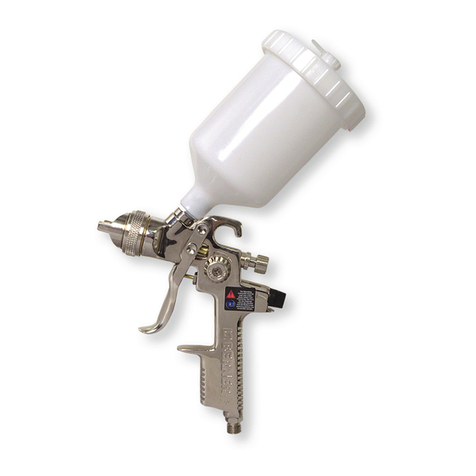
Berner
Berner BPT-PSG RP Instruction manual/safety instruction
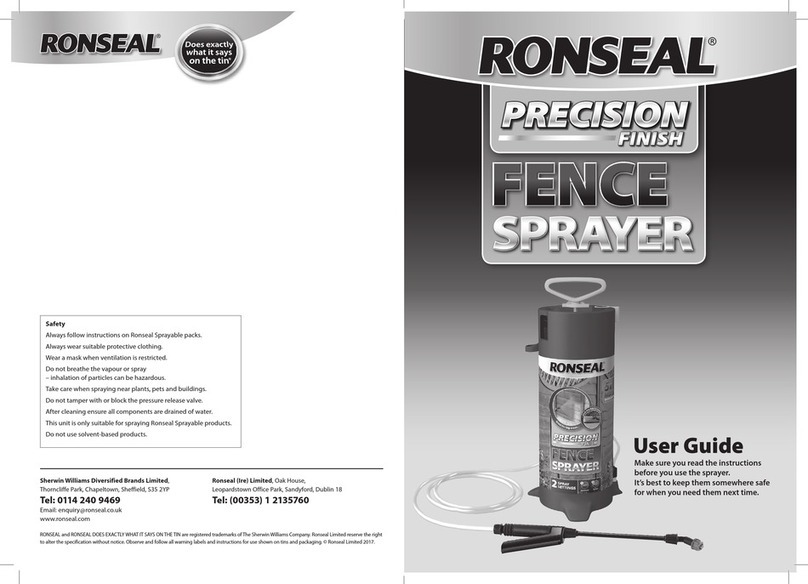
RONSEAL
RONSEAL Precision Finish Fence Sprayer user guide

SAMES KREMLIN
SAMES KREMLIN M 250 instruction manual
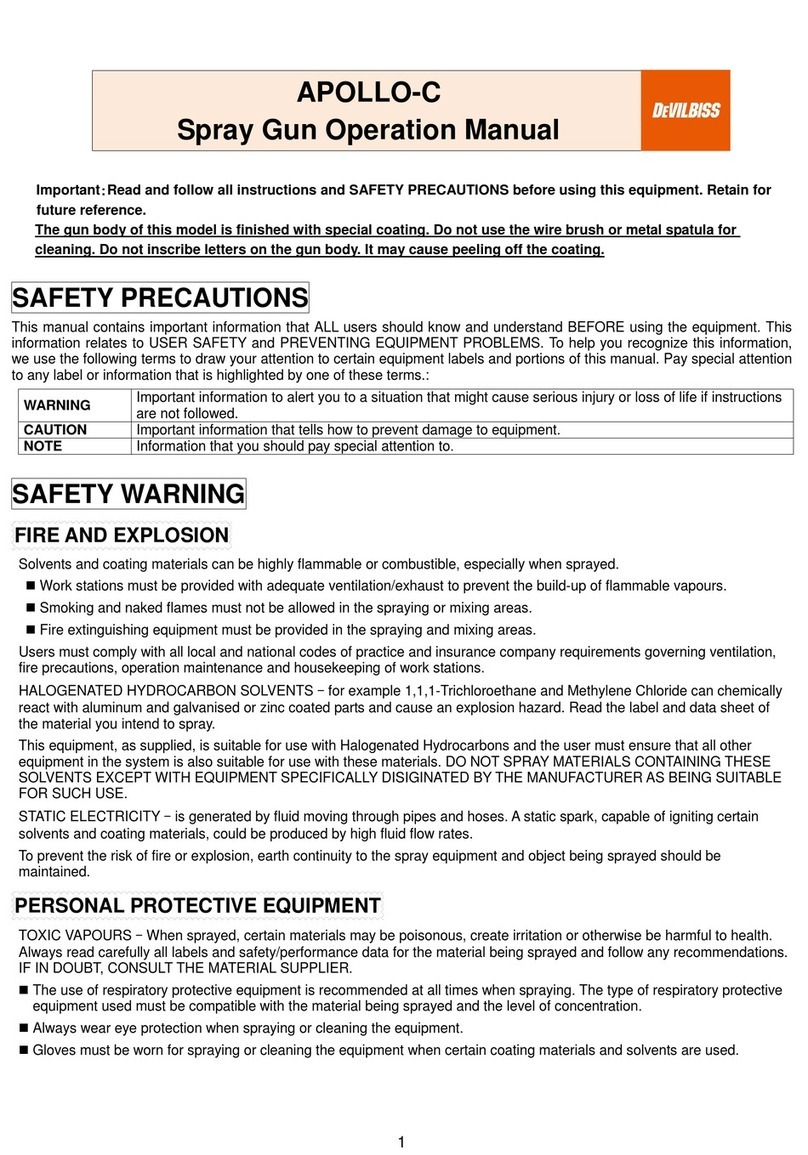
DeVilbiss
DeVilbiss APOLLO-C Series Operation manual
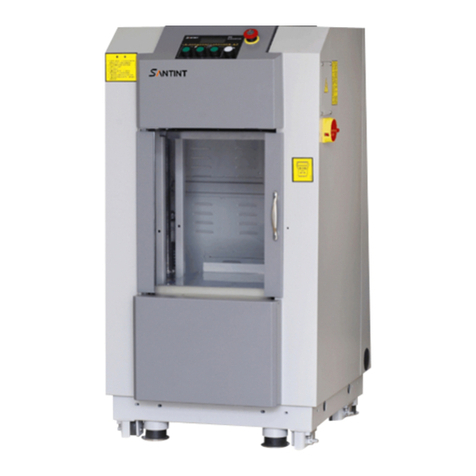
Santint
Santint S5 user manual

Kremlin-Rexson
Kremlin-Rexson M 22 G HTI Adjustment manual

Ozito
Ozito ABK-PRO instruction manual
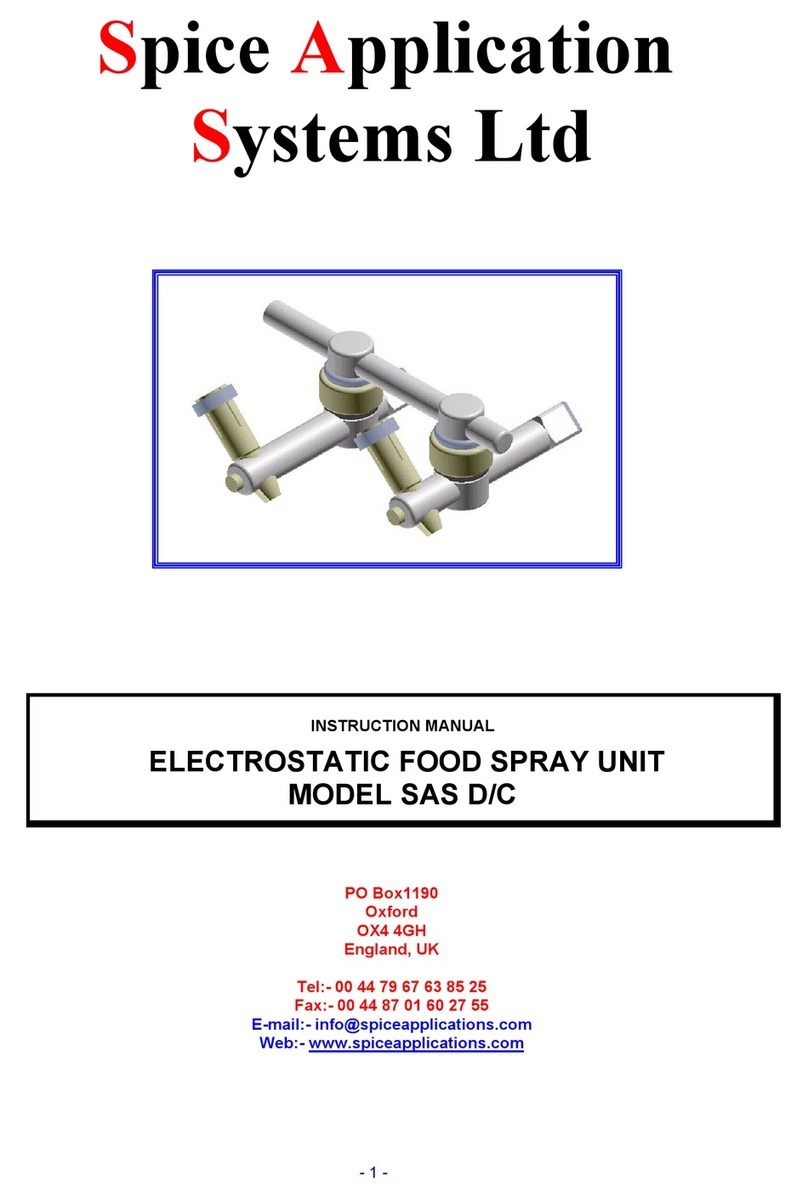
Spice Application Systems
Spice Application Systems SAS D/C instruction manual
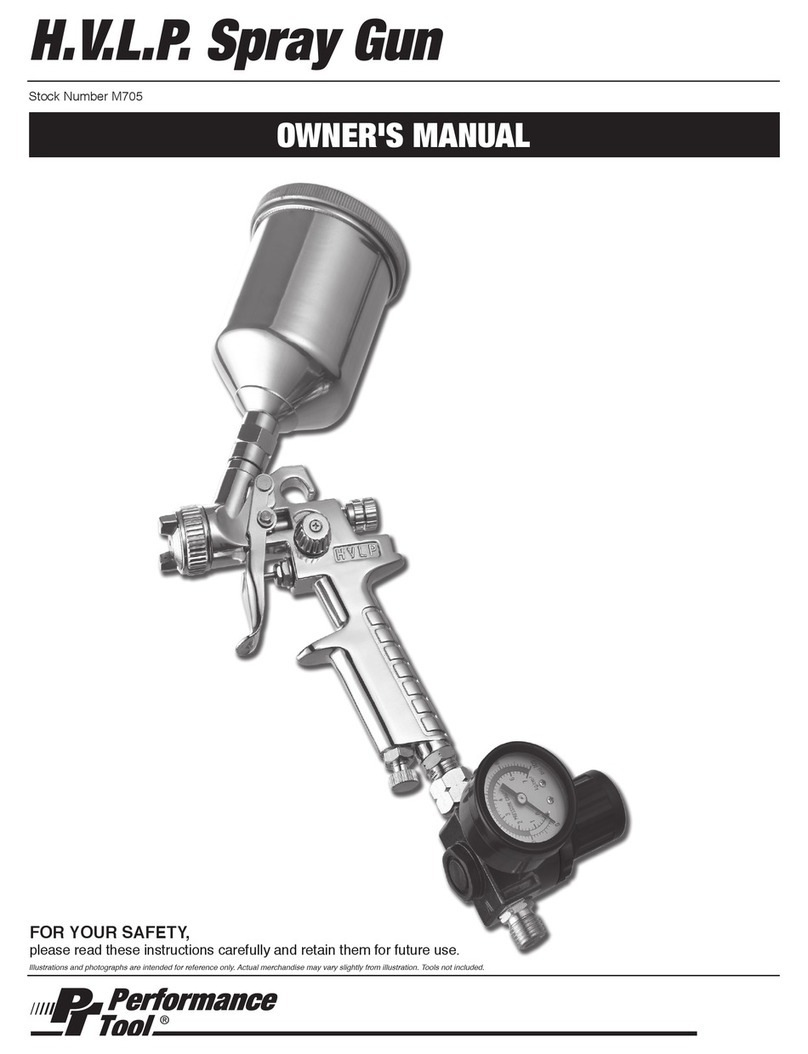
Performance Tool
Performance Tool H.V.L.P. Spray Gun owner's manual
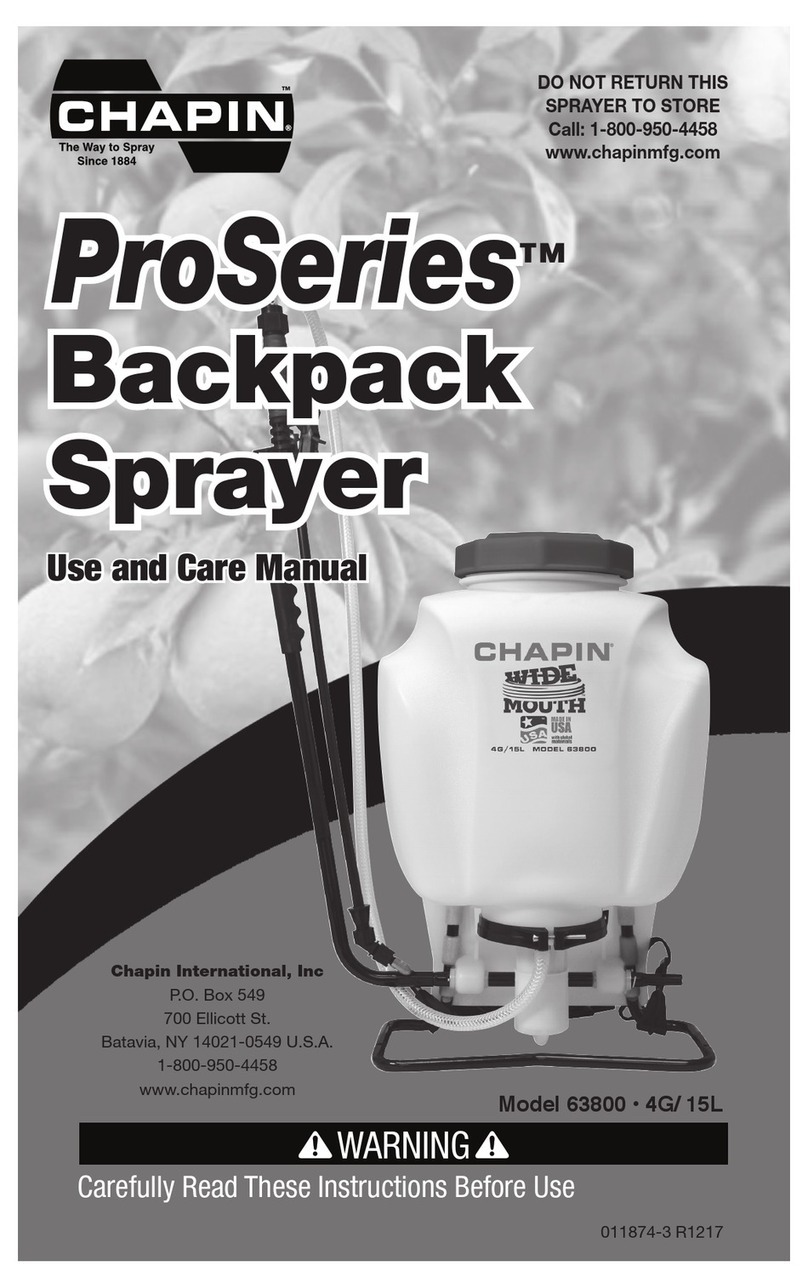
Chapin
Chapin ProSeries 63800 use and care manual
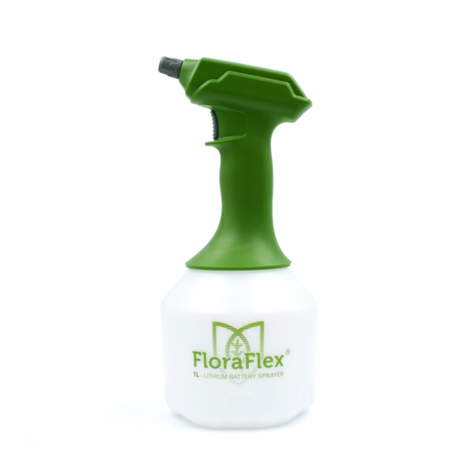
FloraFlex
FloraFlex 1533 instruction manual

Solo
Solo CLEANLine 303 FA Original instructions
